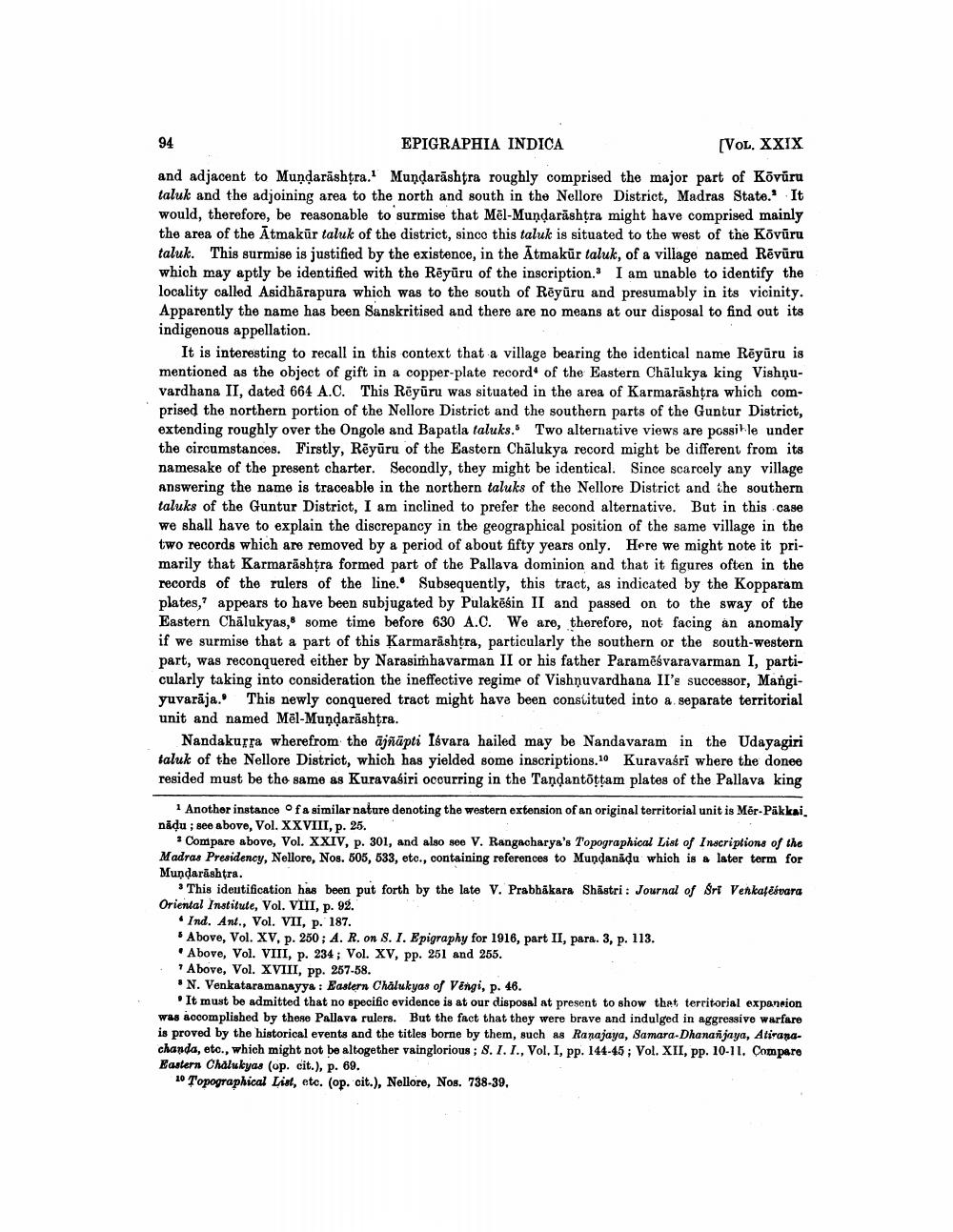________________
94
EPIGRAPHIA INDICA
[VOL. XXIX
and adjacent to Mundarashtra. Mundarashtra roughly comprised the major part of Kōvüru taluk and the adjoining area to the north and south in the Nellore District, Madras State. It would, therefore, be reasonable to surmise that Mel-Munḍarashtra might have comprised mainly the area of the Atmakur taluk of the district, since this taluk is situated to the west of the Kōvūru taluk. This surmise is justified by the existence, in the Atmakur taluk, of a village named Rēvuru which may aptly be identified with the Reyuru of the inscription. I am unable to identify the locality called Asidharapura which was to the south of Reyūru and presumably in its vicinity. Apparently the name has been Sanskritised and there are no means at our disposal to find out its indigenous appellation.
It is interesting to recall in this context that a village bearing the identical name Rēyūru is mentioned as the object of gift in a copper-plate record of the Eastern Chalukya king Vishnuvardhana II, dated 664 A.C. This Reyūru was situated in the area of Karmarashtra which comprised the northern portion of the Nellore District and the southern parts of the Guntur District, extending roughly over the Ongole and Bapatla taluks. Two alternative views are possible under the circumstances. Firstly, Reyūru of the Eastern Chalukya record might be different from its namesake of the present charter. Secondly, they might be identical. Since scarcely any village answering the name is traceable in the northern taluks of the Nellore District and the southern taluks of the Guntur District, I am inclined to prefer the second alternative. But in this case we shall have to explain the discrepancy in the geographical position of the same village in the two records which are removed by a period of about fifty years only. Here we might note it primarily that Karmarashtra formed part of the Pallava dominion and that it figures often in the records of the rulers of the line. Subsequently, this tract, as indicated by the Kopparam plates, appears to have been subjugated by Pulakesin II and passed on to the sway of the Eastern Chalukyas, some time before 630 A.C. We are, therefore, not facing an anomaly if we surmise that a part of this Karmarashtra, particularly the southern or the south-western part, was reconquered either by Narasimhavarman II or his father Parameśvaravarman I, particularly taking into consideration the ineffective regime of Vishnuvardhana II's successor, Mangiyuvarāja. This newly conquered tract might have been constituted into a separate territorial unit and named Mel-Mundarashtra.
Nandakurra wherefrom the ajñāpti Isvara hailed may be Nandavaram in the Udayagiri taluk of the Nellore District, which has yielded some inscriptions.10 Kuravaśrī where the donee resided must be the same as Kuravaśiri occurring in the Tandantōṭṭam plates of the Pallava king
1 Another instance of a similar nature denoting the western extension of an original territorial unit is Mer-Päkkai nadu; see above, Vol. XXVIII, p. 25.
* Compare above, Vol. XXIV, p. 301, and also see V. Rangacharya's Topographical List of Inscriptions of the Madras Presidency, Nellore, Nos. 505, 533, etc., containing references to Mundanaḍu which is a later term for Mundarashtra.
3 This identification has been put forth by the late V. Prabhakara Shastri: Journal of Sri Venkatesvara Oriental Institute, Vol. VIII, p. 92.
Ind. Ant., Vol. VII, p. 187.
Above, Vol. XV, p. 250; A. R. on S. I. Epigraphy for 1916, part II, para. 3, p. 113.
Above, Vol. VIII, p. 234; Vol. XV, pp. 251 and 255.
Above, Vol. XVIII, pp. 257-58.
*N. Venkataramanayya: Eastern Chalukyas of Vengi, p. 46.
It must be admitted that no specific evidence is at our disposal at present to show that territorial expansion was accomplished by these Pallava rulers. But the fact that they were brave and indulged in aggressive warfare is proved by the historical events and the titles borne by them, such as Ranajaya, Samara-Dhananjaya, Atiranachanda, etc., which might not be altogether vainglorious; S. I. I., Vol. I, pp. 144-45; Vol. XII, pp. 10-11. Compare Eastern Chalukyas (op. cit.), p. 69.
10 Topographical List, etc. (op. cit.), Nellore, Nos. 738-39,




